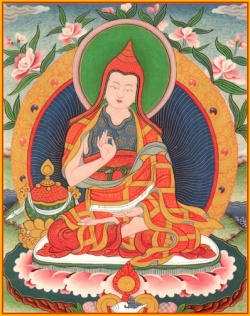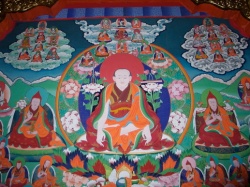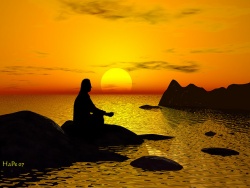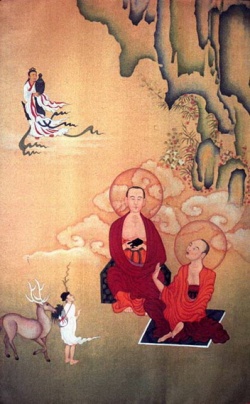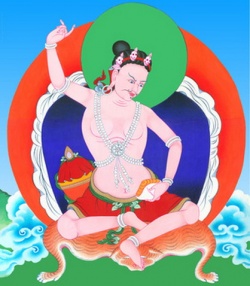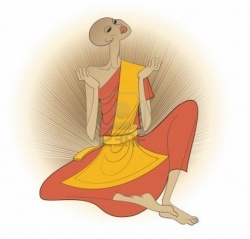Difference between revisions of "Modern Buddhist Rituals of Maharashtra"
(Created page with "{{DisplayImages|299|291|1584|1623|449|625|1564|195|388}} {{Centre|<big><big>Modern Buddhist Rituals of Maharashtra</big></big><br/> Mahesh Ashok Deokar<br/> Professor of {{Wik...") |
|||
| Line 1: | Line 1: | ||
| − | {{DisplayImages|299|291|1584|1623|449|625|1564|195 | + | {{DisplayImages|299|291|1584|1623|449|625|1564|195}} |
| − | {{Centre|<big><big>Modern Buddhist Rituals of Maharashtra</big></big><br/> | + | {{Centre|<big><big>Modern Buddhist Rituals of {{Wiki|Maharashtra}}</big></big><br/> |
| − | Mahesh Ashok Deokar<br/> | + | Mahesh [[Ashok]] Deokar<br/> |
| − | Professor of {{Wiki|University of Pune}}, {{Wiki|India}}<br/>}} | + | {{Wiki|Professor}} of {{Wiki|University of Pune}}, {{Wiki|India}}<br/>}} |
===Introduction=== | ===Introduction=== | ||
| − | In the Kanazawa Cultural Resource Seminar, we are mainly focusing on the preservation of tangible and intangible cultural resources through a number of presentations and | + | In the Kanazawa {{Wiki|Cultural}} Resource Seminar, we are mainly focusing on the preservation of {{Wiki|tangible}} and intangible {{Wiki|cultural}} resources through a number of presentations and field trips. What I am going to discuss today is a unique [[phenomenon]] being witnessed in the {{Wiki|present}} day {{Wiki|Maharashtra}} state of {{Wiki|western}} part of [[India]]. Here a big section of the {{Wiki|society}}, which formerly belonged to the [[Hindu]] [[religion]] converted to [[Buddhism]] through a mass [[conversion]]. It abandoned its old [[Hindu]] {{Wiki|culture}} and is trying to adopt a [[Buddhist]] {{Wiki|culture}}, which suits the {{Wiki|modern}} [[time]]. In a way, it is an attempt to revive the early [[Buddhist]] {{Wiki|culture}} with a {{Wiki|modern}} {{Wiki|perspective}}. Due to the want of [[time]], I should focus on the [[ritual]] aspect of the {{Wiki|culture}} as one of the important means of maintaining {{Wiki|cultural}} [[Wikipedia:Identity (social science)|identity]]. To understand this [[phenomenon]] in the [[right perspective]] the {{Wiki|present}} presentation is divided into two parts: |
| − | Part I: Origin and Development of Buddhist Rituals<br/> | + | Part I: Origin and Development of [[Buddhist]] [[Rituals]]<br/> |
| − | Part II: Modern Buddhist Rituals of Maharashtra<br/> | + | Part II: {{Wiki|Modern}} [[Buddhist]] [[Rituals]] of {{Wiki|Maharashtra}}<br/> |
| − | ==Part I: Origin and Development of Buddhist Rituals== | + | ==Part I: Origin and Development of [[Buddhist]] [[Rituals]]== |
| − | ===A. Protest Against Vedic Ritualism=== | + | ===A. Protest Against {{Wiki|Vedic}} Ritualism=== |
| − | Buddhism originated and flourished on the background of predominantly ritualistic Vedic culture. The Buddha opposed unethical | + | [[Buddhism]] originated and flourished on the background of predominantly [[ritualistic]] {{Wiki|Vedic}} {{Wiki|culture}}. The [[Buddha]] opposed {{Wiki|unethical}} sacrifices prescribed in {{Wiki|Vedic}} [[scriptures]]. These include killing of [[animals]], cutting of [[trees]] and undue taxation on common masses. The [[Buddha]] rejected {{Wiki|sacrifice}} as a means of [[attaining]] [[Wikipedia:Absolute (philosophy)|ultimate]] [[purity]] and [[liberation]]. According to him, complete [[mental]] [[purity]] cannot be achieved through [[rites]] and [[rituals]]. These rather act as [[fetters]] in one’s [[spiritual]] progress. |
| − | ===B. Buddha’s Acceptance of Ethical Rituals=== | + | ===B. [[Buddha’s]] [[Acceptance]] of [[Ethical]] [[Rituals]]=== |
| − | Although the Buddha himself was against the practice of any rite or ritual, he advised pious Brahmins that if at all they want to perform a | + | Although the [[Buddha]] himself was against the practice of any [[rite]] or [[ritual]], he advised pious [[Brahmins]] that if at all they want to perform a {{Wiki|sacrifice}}, they should perform it [[ethically]] that is without killing [[living beings]], or cutting [[trees]]. He told them that the [[purity]] of [[mind]] is the best of sacrifices. The [[Buddha]], the best [[teacher]] as he was, recognised the [[general]] tendency of [[human beings]] to seek support and [[mental]] solace outside themselves in [[rites]] and [[rituals]]. There are instances in the early [[Buddhist canon]] where the [[Buddha]] advised his [[disciples]] not to oppose such [[beliefs]], which do not violate [[moral]] {{Wiki|principles}}. Thus, for the [[Buddha]] [[rituals]] have {{Wiki|social}} and [[psychological]] significance rather than [[religious]]. |
| − | ===C. Origin of Protection Rituals=== | + | ===C. Origin of [[Protection]] [[Rituals]]=== |
| − | It can be observed from the account of the early Buddhist canon that certain discourses given by the Buddha either in his previous birth as a Bodhisattva or in his lifetime on occasion of natural or supernatural disasters laid the foundation of protection rituals. Here it should be borne in mind that these discourses lay greater emphasis on the moral and truthful behaviour as a protection against such calamities. Although initially such rituals only involved the chanting of these discourses, as the time passed on, other ritualistic details were added to it. | + | It can be observed from the account of the early [[Buddhist canon]] that certain discourses given by the [[Buddha]] either in his previous [[birth]] as a [[Bodhisattva]] or in his [[lifetime]] on occasion of natural or [[supernatural]] disasters laid the foundation of [[protection]] [[rituals]]. Here it should be borne in [[mind]] that these discourses lay greater emphasis on the [[moral]] and truthful {{Wiki|behaviour}} as a [[protection]] against such {{Wiki|calamities}}. Although initially such [[rituals]] only involved the [[chanting]] of these discourses, as the [[time]] passed on, other [[ritualistic]] details were added to it. |
| − | ===D. Development and Popularity of Rituals=== | + | ===D. Development and Popularity of [[Rituals]]=== |
| − | The Pàramitàyàna and the Vajrayàna modes of Buddhist practice witnessed development of Buddhist rituals. These were marked by the employment of Buddhist magical hymns (dhàraõãs) and symbolic spiritual drawings ( | + | The [[Pàramitàyàna]] and the Vajrayàna modes of [[Buddhist practice]] witnessed development of [[Buddhist]] [[rituals]]. These were marked by the employment of [[Buddhist]] [[magical]] hymns (dhàraõãs) and [[symbolic]] [[spiritual]] drawings ([[mandalas]]). Such [[rituals]] gained popularity among common masses to which even the predominantly [[Theravàda]] communities were not an exception. |
| − | In the Theravàda countries, the relation between the lay and the monk community is that of give and take. The lay people support the monk community with food and other requirements and monks bring them good luck and prosperity and protection from calamities by performing rituals. | + | In the [[Theravàda]] countries, the [[relation]] between the lay and the [[monk]] {{Wiki|community}} is that of give and take. The [[lay people]] support the [[monk]] {{Wiki|community}} with [[food]] and other requirements and [[monks]] bring them [[good luck]] and {{Wiki|prosperity}} and [[protection]] from {{Wiki|calamities}} by performing [[rituals]]. |
| − | In the Theravàda tradition, a number of discourses popularly known as parittas | + | In the [[Theravàda]] [[tradition]], a number of discourses popularly known as [[parittas]] “[[Protection]] Hymns” were employed in various {{Wiki|ceremonies}} in accordance with their [[ritualistic]] context. Along with the regular {{Wiki|worship}} of the [[Buddha]] image, things such as distributing {{Wiki|holy}} [[water]] [[purified]] with the [[chanting]] of the [[suttas]], scattering {{Wiki|holy}} sand around house, scattering {{Wiki|holy}} grains in the field, tying a [[sacred]] thread are performed. |
| − | In Sri Lanka, the paritta chanting became particularly popular and the ceremony is performed throughout the night in a dramatic fashion. Such rituals are performed on every single occasion such as house-warming, naming ceremony and even before a cricket match! In various Buddhist countries these rituals are combined with regional and ethnic customs, which cannot be called Buddhist in a strict sense. | + | In [[Sri Lanka]], the [[paritta]] [[chanting]] became particularly popular and the {{Wiki|ceremony}} is performed throughout the night in a dramatic fashion. Such [[rituals]] are performed on every single occasion such as house-warming, naming {{Wiki|ceremony}} and even before a cricket match! In various [[Buddhist]] countries these [[rituals]] are combined with regional and {{Wiki|ethnic}} customs, which cannot be called [[Buddhist]] in a strict [[sense]]. |
| − | ==Part II: Modern Buddhist Rituals of Maharashtra== | + | ==Part II: {{Wiki|Modern}} [[Buddhist]] [[Rituals]] of {{Wiki|Maharashtra}}== |
| − | ===A. Revival of Buddhism in India=== | + | ===A. Revival of [[Buddhism in India]]=== |
| − | In the twentieth century, India witnessed revival of Buddhism that was lost to it for almost | + | In the twentieth century, [[India]] witnessed revival of [[Buddhism]] that was lost to it for almost 800 years. Many [[Indian]] [[scholars]] such as [[Acarya]] Dharmananda [[Kosambi]], Mahapaõóita [[Rahula]] Sankrityayana, and [[Bhikshu]] [[Jagdish Kashyap]] made great efforts to bring the [[Buddha’s teaching]] back to the land of its origin. Although the [[Buddha’s teaching]] was introduced to the masses through their writings, [[India]] was still lacking the [[Buddhist]] {{Wiki|community}} that was committed to it. |
| − | 800 years. Many Indian scholars such as Acarya Dharmananda Kosambi, Mahapaõóita | ||
| − | Rahula Sankrityayana, and Bhikshu Jagdish Kashyap made great efforts to bring the Buddha’s | ||
| − | teaching back to the land of its origin. Although the Buddha’s teaching was introduced to | ||
| − | the masses through their writings, India was still lacking the Buddhist community that was | ||
| − | committed to it. | ||
| − | ===B. The Historic Mass Conversion=== | + | ===B. The Historic Mass [[Conversion]]=== |
| − | For ages, India’s low caste Hindu community was suffering from the evils of casteism; a social structure based on graded inequality. Dr. B. R. Ambedkar, who was born as a low caste Hindu, attempted social reforms in the Hindu community. At the failure of his reform, he decided to quit the old religion along with his followers. In 1956, under his visionary leadership, 500,000 low-caste Hindus embraced Buddhism as their religion. Though Dr. Ambedkar himself was not religious in the orthodox sense of the term, he recognised the necessity of religion for the common man. In his view, the true religion (saddhamma) should address the problems of people and should also try to provide solution to them. For him, acceptance of Buddhism was a way to social reform. | + | For ages, India’s low [[caste]] [[Hindu]] {{Wiki|community}} was [[suffering]] from the [[evils]] of {{Wiki|casteism}}; a {{Wiki|social}} structure based on graded inequality. Dr. [[B. R. Ambedkar]], who was born as a low [[caste]] [[Hindu]], attempted {{Wiki|social}} reforms in the [[Hindu]] {{Wiki|community}}. At the failure of his reform, he decided to quit the old [[religion]] along with his followers. In 1956, under his [[visionary]] [[leadership]], 500,000 low-caste [[Hindus]] embraced [[Buddhism]] as their [[religion]]. Though Dr. [[Ambedkar]] himself was not [[religious]] in the {{Wiki|orthodox}} [[sense]] of the term, he recognised the necessity of [[religion]] for the common man. In his [[view]], the true [[religion]] ([[saddhamma]]) should address the problems of [[people]] and should also try to provide solution to them. For him, [[acceptance]] of [[Buddhism]] was a way to {{Wiki|social}} reform. |
| − | ===C. Buddhism: A Religion of the Modern World=== | + | ===C. [[Buddhism]]: A [[Religion]] of the {{Wiki|Modern}} [[World]]=== |
| − | According to Dr. Ambedkar, Buddhism arose at the time when the society in general was under the grip of certain ideas such as: | + | According to Dr. [[Ambedkar]], [[Buddhism]] arose at the [[time]] when the {{Wiki|society}} in [[general]] was under the [[grip]] of certain [[ideas]] such as: |
| − | : 1. Belief in the authority of scriptures; | + | : 1. [[Belief]] in the authority of [[scriptures]]; |
| − | : 2. Belief in transcendental and metaphysical ideas; | + | : 2. [[Belief]] in [[transcendental]] and [[metaphysical]] [[ideas]]; |
| − | : 3. Belief in the | + | : 3. [[Belief]] in the efficacy of [[rites]] and [[rituals]] as means of obtaining [[liberation]]; |
| − | : 4. Belief in social system based on caste hierarchy | + | : 4. [[Belief]] in {{Wiki|social}} system based on [[caste]] {{Wiki|hierarchy}} |
| − | The Buddha rejected these ideas and preached the Dhamma that was based on rationality and ethics. Freedom, equality, justice and human dignity were its corner stones. Thus, Buddhism is the religion of modern time. | + | The [[Buddha]] rejected these [[ideas]] and {{Wiki|preached}} the [[Dhamma]] that was based on {{Wiki|rationality}} and [[ethics]]. Freedom, equality, justice and [[human]] [[dignity]] were its corner stones. Thus, [[Buddhism]] is the [[religion]] of {{Wiki|modern}} [[time]]. |
| − | Dr. Ambedkar wrote his famous work “The Buddha and His | + | Dr. [[Ambedkar]] wrote his famous work “The [[Buddha]] and His [[Dhamma]]” in the [[form]] of a {{Wiki|Gospel}} of [[Buddhism]] in order to introduce the [[Buddha’s teachings]] to the new followers of [[Buddhism]]. His “The [[Buddha]] and His [[Dhamma]]” is not a recast of the [[traditional]] [[Buddhism]]. It rather tries to {{Wiki|present}} [[Buddhist]] [[thought]] in a purely scientifi c and [[rational]] way. According to him, [[Buddhism]] presented by him is neither the Hãnayàna nor the Mahàyàna. He said if at all it is to be named it may be called as the Navayàna. |
| − | Adopting this new form of religion was a great challenge for Dr. Ambedkar and his community. It not only meant maintaining a distinct religio-cultural identity from their former religion i.e. Hinduism but also to evolve a form of Buddhism based on rationality and ethics. As Meera Ambedkar (1968: 6) states | + | Adopting this new [[form]] of [[religion]] was a great challenge for Dr. [[Ambedkar]] and his {{Wiki|community}}. It not only meant maintaining a {{Wiki|distinct}} religio-cultural [[Wikipedia:Identity (social science)|identity]] from their former [[religion]] i.e. [[Hinduism]] but also to evolve a [[form]] of [[Buddhism]] based on {{Wiki|rationality}} and [[ethics]]. As Meera [[Ambedkar]] (1968: 6) states “[[abandoning]] the old [[religion]] means [[abandoning]] [[rites]], [[rituals]] and customs {{Wiki|related}} to that [[religion]]”.<ref>[[Bauddha]] Jiivan Samskar [[Path]], The [[Buddhist]] {{Wiki|Society}} of [[India]], Mumbai, 2006. (First Edition 1968)</ref> [[Observance]] of [[rituals]] is a good means of maintaining one’s [[religious]] [[Wikipedia:Identity (social science)|identity]]. Therefore, besides introducing the [[Buddha’s teaching]] in the [[form]] of “The [[Buddha]] and His [[Dhamma]]”, in 1956 Dr. [[Ambedkar]] also compiled a small booklet the “Bouddha Pooja [[Patha]]” to meet the growing demand of [[people]] to know about [[Buddhist]] [[form]] of {{Wiki|worship}}. Dr. [[Ambedkar]] collected the [[information]] and the {{Wiki|literature}} from [[Sri Lanka]] and supplemented it with some more [[stanzas]] collected from [[Indian]] [[monks]]. He had also promised to bring out another booklet on [[Buddhist]] [[rites]] and [[rituals]], which he could not fulfill in his [[lifetime]]. It was later brought out by the [[Buddhist]] {{Wiki|Society}} of [[India]] in 1968. For this purpose a special committee named the [[Bauddha]] Samskar Samiti was established. The prime [[objective]] of this booklet was to bring uniformity in the [[Buddhist]] [[rites]] and [[rituals]] throughout [[India]] and to establish solidarity between [[India]] and other [[Buddhist]] countries. Keeping in [[view]] Dr. Ambedkar’s {{Wiki|modern}} {{Wiki|perspective}}, the committee tried to make these [[rites]] simple and intelligible to common masses so that they won’t fall in the clutches of {{Wiki|priests}}. Dr. [[Ambedkar]] wanted [[Buddhist]] [[monks]] to work as [[missionaries]] and {{Wiki|social}} reformers and not as {{Wiki|priests}} as in [[Hinduism]]. |
| − | Dr. Ambedkar took a bold step when he being lay person, initiated millions of his followers into Buddhism. While introducing this modern form of Buddhism to his underprivileged brethren, he took utmost care to maintain the distinct identity of Buddhism from Hinduism the legacy of which was deeply rooted in their minds. At the beginning of this mass initiation, Dr. Ambedkar made his followers accept twenty-two vows. Through these vows besides rejecting god and other theist notions such as reincarnation he also asked them to reject Hindu rituals and Brahmin priests. This had a great impact on the minds of modern Buddhists. | + | Dr. [[Ambedkar]] took a bold step when he being lay [[person]], initiated millions of his followers into [[Buddhism]]. While introducing this {{Wiki|modern}} [[form]] of [[Buddhism]] to his underprivileged brethren, he took utmost care to maintain the {{Wiki|distinct}} [[Wikipedia:Identity (social science)|identity]] of [[Buddhism]] from [[Hinduism]] the legacy of which was deeply rooted in their [[minds]]. At the beginning of this mass [[initiation]], Dr. [[Ambedkar]] made his followers accept twenty-two [[vows]]. Through these [[vows]] besides rejecting [[god]] and other {{Wiki|theist}} notions such as [[reincarnation]] he also asked them to reject [[Hindu]] [[rituals]] and [[Brahmin]] {{Wiki|priests}}. This had a great impact on the [[minds]] of {{Wiki|modern}} [[Buddhists]]. |
| − | The modern Buddhist society of Maharashtra performs various rituals in unique form. These rituals include initiation into Buddhism, Naming ceremony, beginning of schooling, engagement, wedding ceremony, land worship, house warming, opening ceremony, establishment of Buddha image, funeral, death memorial, birthday and death anniversary. The presence of monks is not mandatory for their performance. They can be performed even with the help of trained lay people called Bauddhàcàryas. All the rituals are performed in the presence of images of the Buddha and Dr. Ambedkar who is treated as a modern Buddha. Both of them are paid equal tribute by chanting stanzas in their reverence. They are worshipped by lighting candles and offering flowers to the image of the Buddha and flower garland to the image of Dr. Ambedkar. While performing these rituals conscious efforts are made to avoid Hindu religious symbols such as oil lamps, saffron and turmeric powder etc. The rituals are performed by wearing white clothes. On the occasions of opening ceremony, and house warming ceremony, the ribbon of blue colour is used. | + | The {{Wiki|modern}} [[Buddhist]] {{Wiki|society}} of {{Wiki|Maharashtra}} performs various [[rituals]] in unique [[form]]. These [[rituals]] include [[initiation]] into [[Buddhism]], Naming {{Wiki|ceremony}}, beginning of schooling, engagement, [[wedding]] {{Wiki|ceremony}}, land {{Wiki|worship}}, house warming, opening {{Wiki|ceremony}}, establishment of [[Buddha]] image, [[funeral]], [[death]] memorial, birthday and [[death]] anniversary. The presence of [[monks]] is not mandatory for their performance. They can be performed even with the help of trained [[lay people]] called [[Bauddhàcàryas]]. All the [[rituals]] are performed in the presence of images of the [[Buddha]] and Dr. [[Ambedkar]] who is treated as a {{Wiki|modern}} [[Buddha]]. Both of them are paid {{Wiki|equal}} tribute by [[chanting]] [[stanzas]] in their reverence. They are worshipped by lighting {{Wiki|candles}} and [[offering]] [[flowers]] to the image of the [[Buddha]] and [[flower garland]] to the image of Dr. [[Ambedkar]]. While performing these [[rituals]] [[conscious]] efforts are made to avoid [[Hindu]] [[religious]] [[symbols]] such as oil lamps, {{Wiki|saffron}} and {{Wiki|turmeric}} powder etc. The [[rituals]] are performed by wearing white [[clothes]]. On the occasions of opening {{Wiki|ceremony}}, and house warming {{Wiki|ceremony}}, the ribbon of blue {{Wiki|colour}} is used. |
| − | Every ritual is characterised by undertaking of | + | Every [[ritual]] is characterised by {{Wiki|undertaking}} of “[[refuge]] in the [[Triple Gem]]” (tisaraõa) and “[[acceptance]] of [[five moral precepts]]” (panca÷ãla), [[chanting]] of [[suttas]] such as the karaõãyamettasutta or the maïgalasutta, the jayamaïgalagàthà, the sabbasukhagàthà and the dhammapàlanagàthà and a [[religious]] {{Wiki|discourse}} by [[monks]] or [[lay people]]. In case of [[funeral]], both [[cremation]] and burial are acceptable. No importance is given to a particular [[auspicious]] day or [[time]] while performing a [[ritual]]. Convenience of participants seems to be the prime [[concern]] while fi [[xing]] the date and [[time]]. Since the basic core of most of these [[rituals]] is same they do not exhibit variety in their performance. Often these [[rituals]] include certain regional customs, which are not [[Buddhist]]. |
| − | Although the suttas employed in the rituals are in Pali they are always given with translation in the regional language called Marathi and no adherence is shown to the use of Pali. This is in accordance with the Buddha’s permission to learn Dhamma in one’s own language. While providing translations of Pali suttas, special care is taken to translate super normal notions, such as deva | + | Although the [[suttas]] employed in the [[rituals]] are in [[Pali]] they are always given with translation in the regional [[language]] called Marathi and no adherence is shown to the use of [[Pali]]. This is in accordance with the [[Buddha’s]] permission to learn [[Dhamma]] in one’s own [[language]]. While providing translations of [[Pali]] [[suttas]], special care is taken to translate super normal notions, such as [[deva]] “[[god]]”, bhåta “[[ghost]]” etc. An attempt has been made to translate these words from the {{Wiki|modern}} [[Buddhist]] {{Wiki|perspective}}. |
| − | Although recitation of paritta forms an important part of Buddhist rituals in the Theravàda Buddhist countries such as Sri Lanka, Thailand and Myanmar, it is given less importance in modern Buddhist rituals of Maharashtra. Initially parittas were included in the manual published by the Buddhist Society of India and others. However, in later publications such as the Bauddha Vandanà Suttasa§graha published by the Triratna Granthamàlà in 1994, they were omitted saying that it appears to be a Buddhist version of the Satyanàràyaõa worship popular among Hindus. Such rituals are seen as an attempt of turning Buddhism into a ritualistic religion | + | Although {{Wiki|recitation}} of [[paritta]] [[forms]] an important part of [[Buddhist]] [[rituals]] in the [[Theravàda]] [[Buddhist]] countries such as [[Sri Lanka]], [[Thailand]] and [[Myanmar]], it is given less importance in {{Wiki|modern}} [[Buddhist]] [[rituals]] of {{Wiki|Maharashtra}}. Initially [[parittas]] were included in the manual published by the [[Buddhist]] {{Wiki|Society}} of [[India]] and others. However, in later publications such as the [[Bauddha]] Vandanà Suttasa§graha published by the [[Triratna]] Granthamàlà in 1994, they were omitted saying that it appears to be a [[Buddhist]] version of the Satyanàràyaõa {{Wiki|worship}} popular among [[Hindus]]. Such [[rituals]] are seen as an attempt of turning [[Buddhism]] into a [[ritualistic]] [[religion]] benefiting the priestly {{Wiki|community}} than the common masses. |
| − | For modern Buddhist intellectuals, the process of formulating and reformulating modern Buddhist rituals is a continuous process and the manual of Buddhist rituals has not yet become a closed book. According to them, for modern Buddhists, rituals are important only from the social and cultural point of view. They do not have any religious | + | For {{Wiki|modern}} [[Buddhist]] intellectuals, the process of formulating and reformulating {{Wiki|modern}} [[Buddhist]] [[rituals]] is a continuous process and the manual of [[Buddhist]] [[rituals]] has not yet become a closed [[book]]. According to them, for {{Wiki|modern}} [[Buddhists]], [[rituals]] are important only from the {{Wiki|social}} and {{Wiki|cultural}} point of [[view]]. They do not have any [[religious]] significance as in other {{Wiki|theist}} [[religions]]. |
| − | In the recent publications on Buddhist rites and rituals, one can observe a serious concern that these rituals may encourage blind faith or may give rise to wrong belief that by performing these rituals one can attain merit. They also express a fear that if no precaution is taken, the fundamental Buddhist teachings would turn into mere rituals under the pressure of priesthood. These modern intellectuals are also not in favour of evolving uniformity in rituals. According to them, rituals should not be mandatory but voluntary | + | In the recent publications on [[Buddhist]] [[rites]] and [[rituals]], one can observe a serious [[concern]] that these [[rituals]] may encourage [[blind faith]] or may give rise to wrong [[belief]] that by performing these [[rituals]] one can attain [[merit]]. They also express a {{Wiki|fear}} that if no precaution is taken, the fundamental [[Buddhist teachings]] would turn into mere [[rituals]] under the pressure of priesthood. These {{Wiki|modern}} intellectuals are also not in favour of evolving uniformity in [[rituals]]. According to them, [[rituals]] should not be mandatory but voluntary. |
| − | |||
| − | |||
| + | To conclude, {{Wiki|modern}} [[Buddhists]] of {{Wiki|Maharashtra}} accepted [[rituals]] prevalent in the [[Theravada]] [[Buddhist]] countries such as [[Sri Lanka]]. However, the {{Wiki|modern}} [[scientific]] approach of Dr. [[B. R. Ambedkar]] has played an important role in evolving and shaping [[Buddhist]] [[rituals]] of {{Wiki|modern}} {{Wiki|Maharashtra}}. [[Rituals]] are seen more as socio-cultural [[phenomena]] than the [[religious]] one. This has resulted into a {{Wiki|cautious}} and {{Wiki|pragmatic}} approach towards [[rituals]] and the tension between [[acknowledging]] [[rituals]] as a need of common masses on the one hand and maintaining the [[scientific]] and [[rational]] [[character]] of [[Buddhism]] on the other is quite evident in them. This unique [[phenomenon]] reveals how a new {{Wiki|culture}} claiming to be the same as the original is [[consciously]] built from the old {{Wiki|cultural}} resources. | ||
| + | {{reflist}} | ||
{{R}} | {{R}} | ||
[http://crs.w3.kanazawa-u.ac.jp/en/other/doc/03_08researcher%20paper_mahesh.pdf crs.w3.kanazawa-u.ac.jp/en] | [http://crs.w3.kanazawa-u.ac.jp/en/other/doc/03_08researcher%20paper_mahesh.pdf crs.w3.kanazawa-u.ac.jp/en] | ||
Revision as of 12:22, 23 January 2014
Modern Buddhist Rituals of Maharashtra
Mahesh Ashok Deokar
Professor of University of Pune, India
Introduction
In the Kanazawa Cultural Resource Seminar, we are mainly focusing on the preservation of tangible and intangible cultural resources through a number of presentations and field trips. What I am going to discuss today is a unique phenomenon being witnessed in the present day Maharashtra state of western part of India. Here a big section of the society, which formerly belonged to the Hindu religion converted to Buddhism through a mass conversion. It abandoned its old Hindu culture and is trying to adopt a Buddhist culture, which suits the modern time. In a way, it is an attempt to revive the early Buddhist culture with a modern perspective. Due to the want of time, I should focus on the ritual aspect of the culture as one of the important means of maintaining cultural identity. To understand this phenomenon in the right perspective the present presentation is divided into two parts:
Part I: Origin and Development of Buddhist Rituals
Part II: Modern Buddhist Rituals of Maharashtra
Part I: Origin and Development of Buddhist Rituals
A. Protest Against Vedic Ritualism
Buddhism originated and flourished on the background of predominantly ritualistic Vedic culture. The Buddha opposed unethical sacrifices prescribed in Vedic scriptures. These include killing of animals, cutting of trees and undue taxation on common masses. The Buddha rejected sacrifice as a means of attaining ultimate purity and liberation. According to him, complete mental purity cannot be achieved through rites and rituals. These rather act as fetters in one’s spiritual progress.
B. Buddha’s Acceptance of Ethical Rituals
Although the Buddha himself was against the practice of any rite or ritual, he advised pious Brahmins that if at all they want to perform a sacrifice, they should perform it ethically that is without killing living beings, or cutting trees. He told them that the purity of mind is the best of sacrifices. The Buddha, the best teacher as he was, recognised the general tendency of human beings to seek support and mental solace outside themselves in rites and rituals. There are instances in the early Buddhist canon where the Buddha advised his disciples not to oppose such beliefs, which do not violate moral principles. Thus, for the Buddha rituals have social and psychological significance rather than religious.
C. Origin of Protection Rituals
It can be observed from the account of the early Buddhist canon that certain discourses given by the Buddha either in his previous birth as a Bodhisattva or in his lifetime on occasion of natural or supernatural disasters laid the foundation of protection rituals. Here it should be borne in mind that these discourses lay greater emphasis on the moral and truthful behaviour as a protection against such calamities. Although initially such rituals only involved the chanting of these discourses, as the time passed on, other ritualistic details were added to it.
D. Development and Popularity of Rituals
The Pàramitàyàna and the Vajrayàna modes of Buddhist practice witnessed development of Buddhist rituals. These were marked by the employment of Buddhist magical hymns (dhàraõãs) and symbolic spiritual drawings (mandalas). Such rituals gained popularity among common masses to which even the predominantly Theravàda communities were not an exception.
In the Theravàda countries, the relation between the lay and the monk community is that of give and take. The lay people support the monk community with food and other requirements and monks bring them good luck and prosperity and protection from calamities by performing rituals.
In the Theravàda tradition, a number of discourses popularly known as parittas “Protection Hymns” were employed in various ceremonies in accordance with their ritualistic context. Along with the regular worship of the Buddha image, things such as distributing holy water purified with the chanting of the suttas, scattering holy sand around house, scattering holy grains in the field, tying a sacred thread are performed.
In Sri Lanka, the paritta chanting became particularly popular and the ceremony is performed throughout the night in a dramatic fashion. Such rituals are performed on every single occasion such as house-warming, naming ceremony and even before a cricket match! In various Buddhist countries these rituals are combined with regional and ethnic customs, which cannot be called Buddhist in a strict sense.
Part II: Modern Buddhist Rituals of Maharashtra
A. Revival of Buddhism in India
In the twentieth century, India witnessed revival of Buddhism that was lost to it for almost 800 years. Many Indian scholars such as Acarya Dharmananda Kosambi, Mahapaõóita Rahula Sankrityayana, and Bhikshu Jagdish Kashyap made great efforts to bring the Buddha’s teaching back to the land of its origin. Although the Buddha’s teaching was introduced to the masses through their writings, India was still lacking the Buddhist community that was committed to it.
B. The Historic Mass Conversion
For ages, India’s low caste Hindu community was suffering from the evils of casteism; a social structure based on graded inequality. Dr. B. R. Ambedkar, who was born as a low caste Hindu, attempted social reforms in the Hindu community. At the failure of his reform, he decided to quit the old religion along with his followers. In 1956, under his visionary leadership, 500,000 low-caste Hindus embraced Buddhism as their religion. Though Dr. Ambedkar himself was not religious in the orthodox sense of the term, he recognised the necessity of religion for the common man. In his view, the true religion (saddhamma) should address the problems of people and should also try to provide solution to them. For him, acceptance of Buddhism was a way to social reform.
C. Buddhism: A Religion of the Modern World
According to Dr. Ambedkar, Buddhism arose at the time when the society in general was under the grip of certain ideas such as:
- 1. Belief in the authority of scriptures;
- 2. Belief in transcendental and metaphysical ideas;
- 3. Belief in the efficacy of rites and rituals as means of obtaining liberation;
- 4. Belief in social system based on caste hierarchy
The Buddha rejected these ideas and preached the Dhamma that was based on rationality and ethics. Freedom, equality, justice and human dignity were its corner stones. Thus, Buddhism is the religion of modern time.
Dr. Ambedkar wrote his famous work “The Buddha and His Dhamma” in the form of a Gospel of Buddhism in order to introduce the Buddha’s teachings to the new followers of Buddhism. His “The Buddha and His Dhamma” is not a recast of the traditional Buddhism. It rather tries to present Buddhist thought in a purely scientifi c and rational way. According to him, Buddhism presented by him is neither the Hãnayàna nor the Mahàyàna. He said if at all it is to be named it may be called as the Navayàna.
Adopting this new form of religion was a great challenge for Dr. Ambedkar and his community. It not only meant maintaining a distinct religio-cultural identity from their former religion i.e. Hinduism but also to evolve a form of Buddhism based on rationality and ethics. As Meera Ambedkar (1968: 6) states “abandoning the old religion means abandoning rites, rituals and customs related to that religion”.[1] Observance of rituals is a good means of maintaining one’s religious identity. Therefore, besides introducing the Buddha’s teaching in the form of “The Buddha and His Dhamma”, in 1956 Dr. Ambedkar also compiled a small booklet the “Bouddha Pooja Patha” to meet the growing demand of people to know about Buddhist form of worship. Dr. Ambedkar collected the information and the literature from Sri Lanka and supplemented it with some more stanzas collected from Indian monks. He had also promised to bring out another booklet on Buddhist rites and rituals, which he could not fulfill in his lifetime. It was later brought out by the Buddhist Society of India in 1968. For this purpose a special committee named the Bauddha Samskar Samiti was established. The prime objective of this booklet was to bring uniformity in the Buddhist rites and rituals throughout India and to establish solidarity between India and other Buddhist countries. Keeping in view Dr. Ambedkar’s modern perspective, the committee tried to make these rites simple and intelligible to common masses so that they won’t fall in the clutches of priests. Dr. Ambedkar wanted Buddhist monks to work as missionaries and social reformers and not as priests as in Hinduism.
Dr. Ambedkar took a bold step when he being lay person, initiated millions of his followers into Buddhism. While introducing this modern form of Buddhism to his underprivileged brethren, he took utmost care to maintain the distinct identity of Buddhism from Hinduism the legacy of which was deeply rooted in their minds. At the beginning of this mass initiation, Dr. Ambedkar made his followers accept twenty-two vows. Through these vows besides rejecting god and other theist notions such as reincarnation he also asked them to reject Hindu rituals and Brahmin priests. This had a great impact on the minds of modern Buddhists.
The modern Buddhist society of Maharashtra performs various rituals in unique form. These rituals include initiation into Buddhism, Naming ceremony, beginning of schooling, engagement, wedding ceremony, land worship, house warming, opening ceremony, establishment of Buddha image, funeral, death memorial, birthday and death anniversary. The presence of monks is not mandatory for their performance. They can be performed even with the help of trained lay people called Bauddhàcàryas. All the rituals are performed in the presence of images of the Buddha and Dr. Ambedkar who is treated as a modern Buddha. Both of them are paid equal tribute by chanting stanzas in their reverence. They are worshipped by lighting candles and offering flowers to the image of the Buddha and flower garland to the image of Dr. Ambedkar. While performing these rituals conscious efforts are made to avoid Hindu religious symbols such as oil lamps, saffron and turmeric powder etc. The rituals are performed by wearing white clothes. On the occasions of opening ceremony, and house warming ceremony, the ribbon of blue colour is used.
Every ritual is characterised by undertaking of “refuge in the Triple Gem” (tisaraõa) and “acceptance of five moral precepts” (panca÷ãla), chanting of suttas such as the karaõãyamettasutta or the maïgalasutta, the jayamaïgalagàthà, the sabbasukhagàthà and the dhammapàlanagàthà and a religious discourse by monks or lay people. In case of funeral, both cremation and burial are acceptable. No importance is given to a particular auspicious day or time while performing a ritual. Convenience of participants seems to be the prime concern while fi xing the date and time. Since the basic core of most of these rituals is same they do not exhibit variety in their performance. Often these rituals include certain regional customs, which are not Buddhist.
Although the suttas employed in the rituals are in Pali they are always given with translation in the regional language called Marathi and no adherence is shown to the use of Pali. This is in accordance with the Buddha’s permission to learn Dhamma in one’s own language. While providing translations of Pali suttas, special care is taken to translate super normal notions, such as deva “god”, bhåta “ghost” etc. An attempt has been made to translate these words from the modern Buddhist perspective.
Although recitation of paritta forms an important part of Buddhist rituals in the Theravàda Buddhist countries such as Sri Lanka, Thailand and Myanmar, it is given less importance in modern Buddhist rituals of Maharashtra. Initially parittas were included in the manual published by the Buddhist Society of India and others. However, in later publications such as the Bauddha Vandanà Suttasa§graha published by the Triratna Granthamàlà in 1994, they were omitted saying that it appears to be a Buddhist version of the Satyanàràyaõa worship popular among Hindus. Such rituals are seen as an attempt of turning Buddhism into a ritualistic religion benefiting the priestly community than the common masses.
For modern Buddhist intellectuals, the process of formulating and reformulating modern Buddhist rituals is a continuous process and the manual of Buddhist rituals has not yet become a closed book. According to them, for modern Buddhists, rituals are important only from the social and cultural point of view. They do not have any religious significance as in other theist religions.
In the recent publications on Buddhist rites and rituals, one can observe a serious concern that these rituals may encourage blind faith or may give rise to wrong belief that by performing these rituals one can attain merit. They also express a fear that if no precaution is taken, the fundamental Buddhist teachings would turn into mere rituals under the pressure of priesthood. These modern intellectuals are also not in favour of evolving uniformity in rituals. According to them, rituals should not be mandatory but voluntary.
To conclude, modern Buddhists of Maharashtra accepted rituals prevalent in the Theravada Buddhist countries such as Sri Lanka. However, the modern scientific approach of Dr. B. R. Ambedkar has played an important role in evolving and shaping Buddhist rituals of modern Maharashtra. Rituals are seen more as socio-cultural phenomena than the religious one. This has resulted into a cautious and pragmatic approach towards rituals and the tension between acknowledging rituals as a need of common masses on the one hand and maintaining the scientific and rational character of Buddhism on the other is quite evident in them. This unique phenomenon reveals how a new culture claiming to be the same as the original is consciously built from the old cultural resources.
